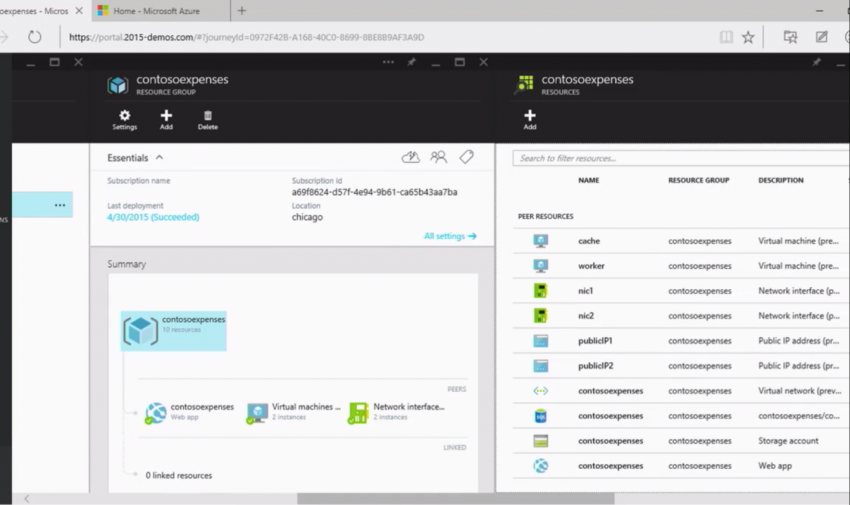Interview with Vijay Tewari of Microsoft About Azure Stack
Microsoft recently launched Azure Stack at the Microsoft Inspire conference, which gives you the ability to run Azure in your own premises. One of the leaders of this strategically important product is Vijay Tewari, a Principal Group Program Manager for Microsoft Azure Stack and hybrid cloud infrastructure and solutions. Vijay kindly agreed to answer some questions about Azure Stack, so our readers could learn a bit more.
The Interview
[Aidan] You’ve announced the availability of the Azure Stack Development Kit and pre-orders of Azure Stack. What is Azure Stack and why does it exist?
[Vijay] Azure Stack is an extension of Azure and facilitates running Azure Services in a customer’s data center. Customers are adopting Azure for a variety of different scenarios and use cases but we have identified three patterns where Azure Stack provides a solution.
Edge and disconnected solutions: You can address latency and connectivity requirements by processing data locally in Azure Stack and then aggregating in Azure for further analytics with common application logic across both. Consider the case of an oil rig or a cruise line, which has computational capacity and would like to have cloud applications provide services to these environments. Customers are desirous of developing cloud applications which can then be deployed to these edge environments.
Cloud applications that meet every regulation: You can develop and deploy applications in Azure. This is with full flexibility to deploy on-premises with Azure Stack to meet your regulatory or policy requirements. Code changes are not needed.
Modern applications across cloud and on-premises: Apply Azure web and mobile services, containers, server-less, and micro-service architectures to update and extend existing applications with Azure Stack, while using a consistent DevOps process across on-premises and cloud.
[Aidan] Can you explain how the “one consistent cloud” experience might play out for customers?
[Vijay] Azure Stack is an extension of Azure. We’re trying to make this ring true in everything we do, such as use cases, product capabilities, support, ecosystem approach, packaging/pricing, etc.
Azure Stack brings the agility and innovation of cloud computing to on-premises environments. Organizations can now build modern applications across hybrid cloud environments with the right flexibility and control.
The consistency is key. Developers can build applications using a consistent set of Azure services and DevOps processes and tools. Then, they collaborate with operations to deploy to the location that best meets the business, technical, and regulatory requirements. Developers can speed up new cloud application development by using pre-built solutions from the Azure Marketplace, including open source tools and technologies.
[Aidan] Azure Stack is going to be a different experience for past Hyper-V customers. I’ve seen Jeffrey Snover joke online that Microsoft shouldn’t share Azure Stack architecture information because customers shouldn’t need to know it. The solution is a “black box”. This means that the rack appears in your data center and that customer access is “limited” to an admin portal and a user portal. Some potential customers might worry about this lack of control but I know you’ve got good reason to take this approach. Would you share that with us?
[Vijay] Azure Stack is really about enabling customers to focus on the apps that provide business value and innovation. We have learned a lot from Azure on what it takes to build and operate a hyperscale cloud that can be updated rapidly. Azure Stack has to keep pace with the innovation from Azure and delivering it as an integrated appliance allows us to update it rapidly. We can do this because the arch is prescribed. We can validate updates before we ship these to the customer. I had recorded a video on this, which is here.
[Aidan] What can customers deploy in Azure Stack today? This isn’t the traditional “RTM” of the past. Can you share some of the plans for Azure Stack?
[Vijay] Azure Stack is like Azure. We will continually ship updates to it, providing new capabilities frequently. This isn’t a system that is deployed and that remains static. Customers are keen to get new capabilities frequently. We have more in a video here.
[Aidan] How can customers evaluate Azure Stack? If they’re happy with it, how can they go about purchasing it?
[Vijay] We have a version of Azure Stack that can be deployed on a single server, called Azure Stack Development Kit. I encourage customers to download and install this on a single server to evaluate various aspects of Azure Stack. To purchase Azure Stack, please reach out to your hardware partner (Dell EMC, HPE and Lenovo now, with Cisco later in Cy’17 and Huawei in early CY’18). More details are here.
My Opinion
Before I share what I think of Azure Stack, I would like to take the time to thank Vijay Tewari for taking the time to answer these questions. Between attending Microsoft Inspire, launching Azure Stack, and the continued development/improvement of the hybrid cloud solution, you can be sure that he is a busy man!
So, what do I think of Azure Stack? I think Azure Stack is a game changer. It has been a long time (12 years) since I was last an on-premises “sys admin” and “owned” on-premises infrastructure. The experiences I had before then still shape my opinions, how I advise, and what I do/teach today. I remember the endless expansion of hardware, the long hours, and the endless fights with the app-dev department. I still warmly remember them for their 2 year project to write their own version of SQL Server Reporting Services using Java (seriously!). Imagine a world where the sys admin spends less time on infrastructure. A private cloud could be wheeled in and operational in days. All you Hyper-V admins who have driver/firmware induced baldness (thank you VMQ on 1GbE and Emulex) should know that Microsoft is forcing the Azure Stack partners to properly configure and QA the hardware. Think of this as a super HCL and variations are not allowed. Imagine that this private cloud was treated like an individual server. I do not have to know how it works. It just works and my job is to manage services. New ways of working, self-service capabilities, cross-charging, and an ability to burst to or use Azure for additional capacities or services would be revolutionary. I think that if I could deploy Azure and Azure Stack into a large enterprise (this is not for small/medium businesses) and change the mindset about ways of working, things would be a lot easier for that enterprise.
Am I going to learn Azure Stack? No. I do not see the point of “learning” Azure Stack. As Jeffrey Snover has joked (above) and Vijay has commented, we do not need to know how Azure Stack works. What is more important is:
- Being able to use the admin portal
- Understanding and using Azure services
The reality is that my last three and half years of learning Azure mean that I have already learned a lot of Azure Stack. Do not deploy the Azure Stack Development Kit to learn how to use Azure Stack. Use Azure. Instead, use the Development Kit to prove the concept of Azure Stack.
I have no idea how the OEMs will price the hardware. Super HCLs have a sad history of creating excuses for price inflation. I do think that Azure Stack is an awesome implementation of the Microsoft mantra: “Cloud is how we work, not where we work.”





![A hybrid or private cloud that you run on-premises - Azure Stack [Image Credit: Microsoft]](https://petri-media.s3.amazonaws.com/2017/07/AzureStackConcept.png)
![This is all you need to know about Azure Stack architecture [Image Credit: Lenovo]](https://petri-media.s3.amazonaws.com/2017/07/LenovoAzureStack.jpg)
